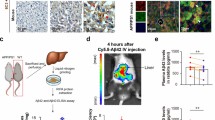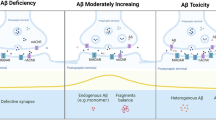Abstract
Alzheimer’s disease (AD) is behaviorally characterized by memory impairments, and pathologically by amyloid β1–42 (Aβ1–42) plaques and tangles. Aβ binds to excitatory synapses and disrupts their transmission due to dysregulation of the glutamate receptors. Here we hypothesized that chronic inhibition of the endocytosis of AMPA receptors together with GluN2B subunit of NMDA receptors might improve cognition deficit induced by Aβ(1–42) neurotoxicity. Forty male Wistar rats were used in this study and divided into 5 groups: Saline + Saline, Aβ+Saline, Aβ+Ifen (Ifenprodil, 3 nmol /2 weeks), Aβ+GluR23Y (Tat-GluR23Y 3 μmol/kg/2 weeks) and Aβ+Ifen+GluR23Y (same doses and durations). Aβ(1–42) neurotoxicity was induced by intracerebroventricular (ICV) injection of Aβ1–42 (2 μg/μl/side), and then animals received the related treatments for 14 days. Cognitive performance of rats and hippocampal level of cAMP-response element-binding (CREB) were evaluated using Morris Water Maze (MWM), and western blotting respectively. Obtained data from the acquisition trials were analyzed by two way Anova and Student T test. Also one way Analysis of variance (ANOVA) with post hoc Tuckey were used to clarify between groups differences in probe test. The Group receiving Aβ, showed significant cognition deficit (long latency to platform and short total time spent in target quadrant (TTS), parallel with lower level of hippocampal CREB, versus vehicle group. While, Aβ+ GluR23Y exhibited the shortest latency to platform and the longest TTS during the probe test, parallel with the higher hippocampal level of CREB compared with other groups. The present study provides evidence that chronic administration of Tat-GluR23Y; an inhibitor of GluA2-AMPARs endocytosis, successfully restores spatial memory impaired by amyloid beta neurotoxicity targeting CREB signaling pathway.




Similar content being viewed by others
Data availablity
The data that support the findings of this study are available from the corresponding author upon reasonable request.
References
Alberdi E et al (2010) Amyloid β oligomers induce Ca2+ dysregulation and neuronal death through activation of ionotropic glutamate receptors. Cell Calcium 47:264–272
Balamotis MA, Tamberg N, Woo YJ, Li J, Davy B, Kohwi-Shigematsu T, Kohwi Y (2012) Satb1 ablation alters temporal expression of immediate early genes and reduces dendritic spine density during postnatal brain development. Mol Cell Biol 32:333–347
Bayer TA, Wirths O (2010) Intracellular accumulation of amyloid-Beta - a predictor for synaptic dysfunction and neuron loss in Alzheimer’s disease. Front Aging Neurosci 2:8. https://doi.org/10.3389/fnagi.2010.00008
Bhatt JM, Prakash A, Suryavanshi PS, Dravid SM (2013) Effect of ifenprodil on GluN1/GluN2B N-methyl-D-aspartate receptor gating. Mol Pharmacol 83:9–21
Bitner RS (2012) Cyclic AMP response element-binding protein (CREB) phosphorylation: a mechanistic marker in the development of memory enhancing Alzheimer’s disease therapeutics. Biochem Pharmacol 83:705–714
Butterfield DA, Pocernich CB (2003) The glutamatergic system and Alzheimer’s disease. CNS Drugs 17:641–652
Chen X, Wagener JF, Morgan DH, Hui L, Ghribi O, Geiger JD (2010) Endolysosome mechanisms associated with Alzheimer’s disease-like pathology in rabbits ingesting cholesterol-enriched diet. J Alzheimers Dis 22:1289–1303
Chen Y et al (2012) Alzheimer’s β-secretase (BACE1) regulates the cAMP/PKA/CREB pathway independently of β-amyloid. J Neurosci 32:11390–11,395
Danysz W, Parsons CG (2012) Alzheimer’s disease, β-amyloid, glutamate, NMDA receptors and memantine–searching for the connections. Br J Pharmacol 167:324–352
Dong Z et al (2015) Long-term potentiation decay and memory loss are mediated by AMPAR endocytosis. J Clin Invest 125:234–247
Gao X et al (2007) NMDA receptor activation induces mitochondrial dysfunction, oxidative stress and apoptosis in cultured neonatal rat cardiomyocytes. Physiol Res 56:559
Guntupalli S, Widagdo J, Anggono V (2016) Amyloid-β-induced dysregulation of AMPA receptor trafficking. Neural Plast 3204519. https://doi.org/10.1155/2016/3204519
Hardingham GE, Bading H (2010) Synaptic versus extrasynaptic NMDA receptor signalling: implications for neurodegenerative disorders. Nat Rev Neurosci 11:682–696
Hardingham GE, Fukunaga Y, Bading H (2002) Extrasynaptic NMDARs oppose synaptic NMDARs by triggering CREB shut-off and cell death pathways. Nat Neurosci 5:405–414
Hardt O, Nader K, Wang Y-T (2014) GluA2-dependent AMPA receptor endocytosis and the decay of early and late long-term potentiation: possible mechanisms for forgetting of short-and long-term memories. Philos Trans R Soc B Biol Sci 369:20130141
He MT, Lee AY, Kim JH, Park CH, Shin YS, Cho EJ (2019) Protective role of Cordyceps militaris in Aβ 1–42-induced Alzheimer’s disease in vivo. Food Sci Biotechnol 28:865–872
Hendricson AW, Miao CL, Lippmann MJ, Morrisett RA (2002) Ifenprodil and ethanol enhance NMDA receptor-dependent long-term depression. J Pharmacol Exp Ther 301:938–944. https://doi.org/10.1124/jpet.301.3.938
Hettinger JC, Lee H, Bu G, Holtzman DM, Cirrito JR (2018) AMPA-ergic regulation of amyloid-β levels in an Alzheimer’s disease mouse model. Mol Neurodegener 13:22. https://doi.org/10.1186/s13024-018-0256-6
Hsieh H, Boehm J, Sato C, Iwatsubo T, Tomita T, Sisodia S, Malinow R (2006) AMPAR removal underlies Aβ-induced synaptic depression and dendritic spine loss. Neuron 52:831–843
Huang Y et al (2017) Modulating the balance of synaptic and extrasynaptic NMDA receptors shows positive effects against amyloid-β-induced neurotoxicity. J Alzheimers Dis 57:885–897
Jalilzad M, Jafari A, Babaei P (2019) Neuregulin1β improves both spatial and associative learning and memory in Alzheimer model of rats possibly through signaling pathways other than Erk1/2. Neuropeptides 78:101963
Kamenetz F et al (2003) APP processing and synaptic function. Neuron 37:925–937. https://doi.org/10.1016/s0896-6273(03)00124-7
Kim J, Kwon J-T, Kim H-S, Josselyn SA, Han J-H (2014) Memory recall and modifications by activating neurons with elevated CREB. Nat Neurosci 17:65
Lakhina V et al (2015) Genome-wide functional analysis of CREB/long-term memory-dependent transcription reveals distinct basal and memory gene expression programs. Neuron 85:330–345
Legendre P, Westbrook GL (1991) Ifenprodil blocks N-methyl-D-aspartate receptors by a two-component mechanism. Mol Pharmacol 40:289–298
Li L, Liu X, Qiao C, Chen G, Li T (2016) Ifenprodil Attenuates Methamphetamine-Induced Behavioral Sensitization and Activation of Ras-ERK-∆ FosB Pathway in the Caudate Putamen. Neurochem Res 41:2636–2644
Liu J, Chang L, Song Y, Li H, Wu Y (2019) The role of NMDA receptors in Alzheimer’s disease. Front Neurosci. https://doi.org/10.3389/fnins.2019.00043
Lüscher C, Malenka RC (2012) NMDA receptor-dependent long-term potentiation and long-term depression (LTP/LTD). Cold Spring Harb Perspect Biol 4:a005710
Ma YY, Yu P, Guo CY, Cui CL (2011) Effects of ifenprodil on morphine-induced conditioned place preference and spatial learning and memory in rats. Neurochem Res 36:383–391. https://doi.org/10.1007/s11064-010-0342-9
Melgarejo da Rosa M, Yuanxiang P, Brambilla R, Kreutz MR, Karpova A (2016) Synaptic GluN2B/CaMKII-α signaling induces synapto-nuclear transport of ERK and Jacob. Front Mol Neurosci 9:66
Morris R (1989) Synaptic plasticity and learning: selective impairment of learning rats and blockade of long-term potentiation in vivo by the N-methyl-D-aspartate receptor antagonist AP5. J Neurosci 9:3040–3057
Morris R, Anderson E, Lynch GS, Baudry M (1986) Selective impairment of learning and blockade of long-term potentiation by an N-methyl-D-aspartate receptor antagonist, AP5. Nature 319:774–776
O’Brien RJ, Wong PC (2011) Amyloid precursor protein processing and Alzheimer’s disease. Annu Rev Neurosci 34:185–204
Paoletti P, Bellone C, Zhou Q (2013) NMDA receptor subunit diversity: impact on receptor properties, synaptic plasticity and disease. Nat Rev Neurosci 14:383–400
Paramanik V, Thakur MK (2013) Role of CREB signaling in aging brain. Arch Ital Biol 151:33–42
Paxinos G and Watson Ch (2013) The rat brain in stereotaxic coordinates 7th edition. Academic Press
Pirotte B, Francotte P, Goffin E, de Tullio P (2013) AMPA receptor positive allosteric modulators: a patent review. Expert Opin Ther Pat 23:615–628. https://doi.org/10.1517/13543776.2013.770840
Pourmir M, Babaei P, Soltani TB (2016) Kisspeptin-13 ameliorates memory impairment induced by streptozotocin in male rats via cholinergic system. Physiol Pharmacol 20(1):38–47
Rammes G et al (2017) Involvement of GluN2B subunit containing N-methyl-d-aspartate (NMDA) receptors in mediating the acute and chronic synaptotoxic effects of oligomeric amyloid-beta (Abeta) in murine models of Alzheimer’s disease (AD). Neuropharmacology 123:100–115. https://doi.org/10.1016/j.neuropharm.2017.02.003
Sánchez-Blázquez P, Rodríguez-Muñoz M, Herrero-Labrador R, Burgueño J, Zamanillo D, Garzón J (2014) The calcium-sensitive Sigma-1 receptor prevents cannabinoids from provoking glutamate NMDA receptor hypofunction: implications in antinociception and psychotic diseases. Int J Neuropsychopharmacol 17:1943–1955
Saura CA, Valero J (2011) The role of CREB signaling in Alzheimer’s disease and other cognitive disorders. Rev Neurosci 22:153–169
Scoville WB, Milner B (2000) Loss of recent memory after bilateral hippocampal lesions. 1957. J Neuropsychiatry Clin Neurosci 12(1):103–113
Shen W-X, Chen J-H, Lu J-H, Peng Y-P, Qiu Y-H (2014) TGF-β1 protection against Aβ1–42-induced neuroinflammation and neurodegeneration in rats. Int J Mol Sci 15:22092–22108
Stanciu GD et al (2020) Alzheimer’s disease pharmacotherapy in relation to cholinergic system involvement. Biomolecules 10(1)40
Talantova M et al (2013) Abeta induces astrocytic glutamate release, extrasynaptic NMDA receptor activation, and synaptic loss. Proc Natl Acad Sci U S A 110:E2518–E2527. https://doi.org/10.1073/pnas.1306832110
Tu S, Okamoto S-I, Lipton SA, Xu H (2014) Oligomeric Aβ-induced synaptic dysfunction in Alzheimer’s disease. Mol Neurodegener 14(9):48. https://doi.org/10.1186/1750-1326-9-48
Vanhoutte P, Bading H (2003) Opposing roles of synaptic and extrasynaptic NMDA receptors in neuronal calcium signalling and BDNF gene regulation. Curr Opin Neurobiol 13:366–371
Varga E, Juhász G, Bozsó Z, Penke B, Fülöp L, Szegedi V (2015) Amyloid-β 1–42 disrupts synaptic plasticity by altering glutamate recycling at the synapse. J Alzheimers Dis 45:449–456
Vitolo OV, Sant’Angelo A, Costanzo V, Battaglia F, Arancio O, Shelanski M (2002) Amyloid β-peptide inhibition of the PKA/CREB pathway and long-term potentiation: reversibility by drugs that enhance cAMP signaling. Proc Natl Acad Sci 99:13217–13,221
Vyklicky V et al (2014) Structure, function, and pharmacology of NMDA receptor channels. Physiol Res 63(1):S191–203. https://doi.org/10.33549/physiolres.932678
Wang H, Xu J, Lazarovici P, Quirion R, Zheng W (2018) cAMP response element-binding protein (CREB): a possible signaling molecule link in the pathophysiology of schizophrenia. Front Mol Neurosci 11:–255
Whitcomb DJ et al (2015) Intracellular oligomeric amyloid-beta rapidly regulates GluA1 subunit of AMPA receptor in the hippocampus. Sci Rep 5:10934
Williams K (2008) Biology of the NMDA Receptor. In: Van Dongen AM (ed). CRC Press/Taylor & Francis, Boca Raton
Yamin G (2009) NMDA receptor–dependent signaling pathways that underlie amyloid β-protein disruption of LTP in the hippocampus. J Neurosci Res 87:1729–1736
Yang K, Xiong W, Yang G, Kojic L, Taghibiglou C, Wang YT, Cynader M (2011) The regulatory role of long-term depression in juvenile and adult mouse ocular dominance plasticity. Sci Rep 1:203
Yin JC, Tully T (1996) CREB and the formation of long-term memory. Curr Opin Neurobiol 6:264–268. https://doi.org/10.1016/s0959-4388(96)80082-1
Yu Y, Huang Z, Dai C, Du Y, Han H, Wang YT, Dong Z (2018) Facilitated AMPAR endocytosis causally contributes to the maternal sleep deprivation-induced impairments of synaptic plasticity and cognition in the offspring rats. Neuropharmacology 133:155–162
Zhang Y, Li P, Feng J, Wu M (2016) Dysfunction of NMDA receptors in Alzheimer’s disease. Neurol Sci 37:1039–1047
Zhang J et al. (2017) Endophilin2 Interacts with GluA1 to Mediate AMPA receptor endocytosis induced by oligomeric amyloid-β Neural Plast 2017.
Zhao W-Q et al (2010) Inhibition of calcineurin-mediated endocytosis and α-amino-3-hydroxy-5-methyl-4-isoxazolepropionic acid (AMPA) receptors prevents amyloid β oligomer-induced synaptic disruption. J Biol Chem 285:7619–7632
Acknowledgements
Authors would like to thank Dr. Bahram Soltani, head of Cellular & Molecular Research Center and department of pharmacology, Faculty of medicine, Rasht, Iran for their laboratory facilities and technical support.
Funding
This work was a master science student thesis and financially was supported by the grant (No IR.GUMS.REC.1396.264) from Research deputy of Guilan University of Medical Sciences, Rasht, Iran.
Author information
Authors and Affiliations
Contributions
PB designed the study, and interpreted data, had a major contribution in writing and revising the manuscript. FA performed experiment, drafted the manuscript and analyzed data. AJ interpreted western blot data. All authors read and approved the final manuscript.
Corresponding author
Ethics declarations
Conflict of interest
The author declare that they have no conflict of interest.
Additional information
Publisher’s note
Springer Nature remains neutral with regard to jurisdictional claims in published maps and institutional affiliations.
Rights and permissions
About this article
Cite this article
Ashourpour, F., Jafari, A. & Babaei, P. Chronic administration of Tat-GluR23Y ameliorates cognitive dysfunction targeting CREB signaling in rats with amyloid beta neurotoxicity. Metab Brain Dis 36, 701–709 (2021). https://doi.org/10.1007/s11011-020-00662-8
Received:
Accepted:
Published:
Issue Date:
DOI: https://doi.org/10.1007/s11011-020-00662-8




